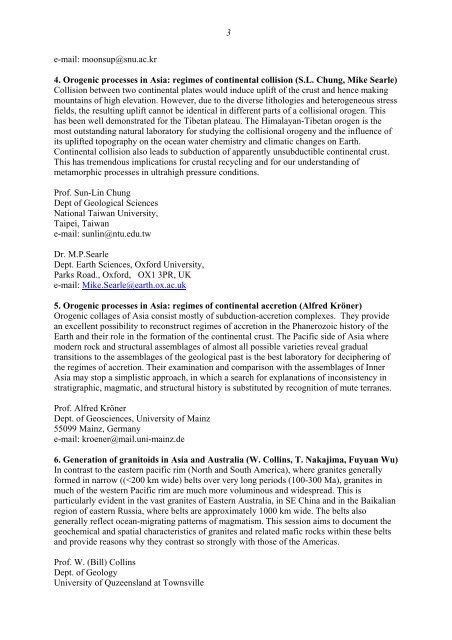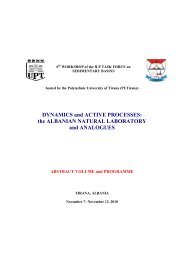JOHANNES GUTENBERG-UNIVERSITÄT MAINZ - International ...
JOHANNES GUTENBERG-UNIVERSITÄT MAINZ - International ...
JOHANNES GUTENBERG-UNIVERSITÄT MAINZ - International ...
Create successful ePaper yourself
Turn your PDF publications into a flip-book with our unique Google optimized e-Paper software.
e-mail: moonsup@snu.ac.kr<br />
3<br />
4. Orogenic processes in Asia: regimes of continental collision (S.L. Chung, Mike Searle)<br />
Collision between two continental plates would induce uplift of the crust and hence making<br />
mountains of high elevation. However, due to the diverse lithologies and heterogeneous stress<br />
fields, the resulting uplift cannot be identical in different parts of a collisional orogen. This<br />
has been well demonstrated for the Tibetan plateau. The Himalayan-Tibetan orogen is the<br />
most outstanding natural laboratory for studying the collisional orogeny and the influence of<br />
its uplifted topography on the ocean water chemistry and climatic changes on Earth.<br />
Continental collision also leads to subduction of apparently unsubductible continental crust.<br />
This has tremendous implications for crustal recycling and for our understanding of<br />
metamorphic processes in ultrahigh pressure conditions.<br />
Prof. Sun-Lin Chung<br />
Dept of Geological Sciences<br />
National Taiwan University,<br />
Taipei, Taiwan<br />
e-mail: sunlin@ntu.edu.tw<br />
Dr. M.P.Searle<br />
Dept. Earth Sciences, Oxford University,<br />
Parks Road., Oxford, OX1 3PR, UK<br />
e-mail: Mike.Searle@earth.ox.ac.uk<br />
5. Orogenic processes in Asia: regimes of continental accretion (Alfred Kröner)<br />
Orogenic collages of Asia consist mostly of subduction-accretion complexes. They provide<br />
an excellent possibility to reconstruct regimes of accretion in the Phanerozoic history of the<br />
Earth and their role in the formation of the continental crust. The Pacific side of Asia where<br />
modern rock and structural assemblages of almost all possible varieties reveal gradual<br />
transitions to the assemblages of the geological past is the best laboratory for deciphering of<br />
the regimes of accretion. Their examination and comparison with the assemblages of Inner<br />
Asia may stop a simplistic approach, in which a search for explanations of inconsistency in<br />
stratigraphic, magmatic, and structural history is substituted by recognition of mute terranes.<br />
Prof. Alfred Kröner<br />
Dept. of Geosciences, University of Mainz<br />
55099 Mainz, Germany<br />
e-mail: kroener@mail.uni-mainz.de<br />
6. Generation of granitoids in Asia and Australia (W. Collins, T. Nakajima, Fuyuan Wu)<br />
In contrast to the eastern pacific rim (North and South America), where granites generally<br />
formed in narrow ((




